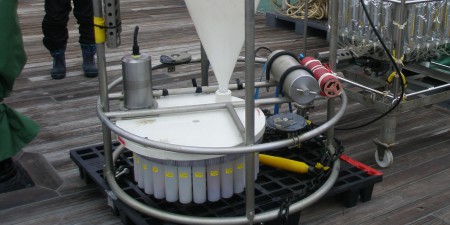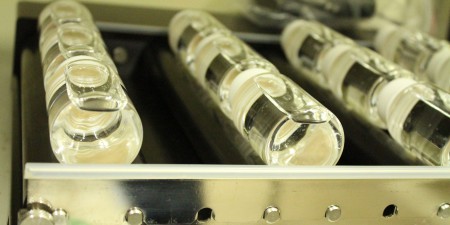The concentration in the Earth’s atmosphere of carbon dioxide—a greenhouse gas—has been rising since the industrial revolution due to emissions associated with human activity. This is one cause of the phenomenon of global warming (climate change). For this reason, it is tempting to think of carbon dioxide as a pollutant produced by mankind; however, in reality carbon dioxide is a source of carbon that is essential for the continuing survival of life on earth, with marine life being no exception. Phytoplankton—plants whose habitat is the euphotic layer (the ocean layer ranging from the ocean surface to the depth of light penetration)—is an active producer of organic matter via photosynthesis, with carbon dioxide as a raw material. The volume of organic matter produced by phytoplankton has been estimated to be 50 billion tons (carbon equivalent) per year. For comparison, the volume of carbon dioxide emitted each year due to combustion of fossil fuels and other human activity is 7 billon tons. Thus, the quantity of carbon dioxide absorbed by phytoplankton by photosynthesis is more than 7 times the amount of carbon dioxide produced by human activity.
What is the biological pump?
The organic matter produced by phytoplankton proceeds through the food chain, supporting the production of zooplankton and fish, and ultimately finding its way to our dinner tables. Approximately 80% of the organic matter produced by photosynthesis reverts to carbon dioxide as it passes through this food chain—through metabolic processes and the death (decomposition) of living organisms—and is quickly returned to the atmosphere. The remaining 20% (which is still an enormous amount, on the order of 10 billion tons) is transported to deep ocean layers, where it is stored on centennial to even millennial timescales in the ocean. The existence of this stored carbon helps restrain the increase in the atmospheric concentration of carbon dioxide. In other words, the storage of carbon dioxide in deep ocean layers acts as a brake, slowing the progress of global warming.
This phenomenon of vertical carbon transport from the euphotic layer to deep ocean layers is known as the “biological pump.” Despite the important role of the biological pump as a factor influencing climate and the carbon cycle on a global scale, many questions remain unanswered regarding its mechanism and the factors that affect it. In particular, if we assume that rising ocean temperatures and climate variations will induce changes in ocean currents at some future point, will this strengthen or weaken the function of the biological pump? Questions like this are of profound relevance to our present and future wellbeing. In considering this problem, the need to acquire a more thorough understanding of the mechanism of the biological pump and the factors affecting its function has become a critical issue.
In this research project, we study systems of interaction between organic matter and microorganisms—which are relevant to the function of the biological pump—from a variety of perspectives; our goal is to acquire a deeper understanding of the mechanism by which oceans store carbon and the factors affecting this process. Below we discuss one such ongoing area of research.
The formation of marine snow
The biological pump involves a complex interaction among various biological and physico-chemical processes. Among these is the sedimentation of an organic aggregates of indefinite shape known as marine snow, which is thought to be one of the key mechanisms of organic carbon transport. The term derives from the observation that, upon shining light through ocean water, clumps with different shapes resembling snow seem to “fall” like snowflakes. Needless to say, these are not actually small flakes of ice that comprise actual snow. Marine snow (aggregates of organic matter) is formed when various polymers of organic compounds—released by many forms of marine life (particularly microorganisms) and their remains after death—collide in ocean water and bind weakly to form clumps of sediment. However, many details surrounding this phenomenon remain unknown, including the conditions under which marine snow is formed, grows, and eventually decays.
In this research, with the goal of gaining deeper understanding of the control mechanisms that govern the biological pump, we pursue a variety of experimental avenues: surveying the distribution of the small particles that form “seeds” for the formation of marine snow in oceans, conducting experimental tests on the factors influencing the speed of aggregate sedimentation, and clarifying the mechanisms responsible for the growth of aggregates into large clusters.




